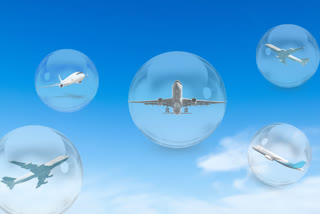Hyderabad: Taking a step further towards resumption of international air travel after nations began shutting their borders earlier this year in response to the coronavirus outbreak, India on Thursday said it has established individual bilateral ‘air bubbles’ with France, Germany and the US that will allow airlines of each country in the pact to operate international flights.
Under the agreement, Air France will be operating 28 flights between Delhi, Mumbai, Bengaluru and Paris from 18 July to 1 August, while United Airlines of the US will be flying 18 flights between 17 July and 31 July.
“Till international civil aviation can reclaim its pre-Covid numbers, I think answer will lie through bilateral air bubbles, which will carry a possible number of people but under defined conditions as countries are still imposing entry restrictions including India,” civil aviation minister Hardeep Singh Puri said.
For those wondering what exactly are ‘air bubbles’ and why has the Indian aviation sector taken this route despite the end of the Coronavirus pandemic being nowhere in sight, here’s a detailed explanation:
What is an air bubble?
Air bubble or travel bubble is essentially an agreement between two countries that allows for travel across borders for non-essential trips.
Under such deals, fixed number of flights operate non-stop between pre-agreed destinations for a certain duration of time. Usually, such corridors exempt long quarantines for citizens of both the countries. However, the conditions may vary depending on different arrangements with different nations.
Why did India consider air bubbles?
India started considering air bubbles after the US complained that India was violating flight agreements by banning US airlines but allowing Air India to operate under the Vande Bharat Mission to bring Indian citizens back from several nations.
A notice by the US Department of Transportation dated 22 June said: “It appears that Air India may be using its passenger repatriation charters as a way of circumventing the GoI (government of India)-imposed prohibition of all scheduled services. This situation… creates a competitive disadvantage for US carriers vis-à-vis Indian carriers.”
Hence, forming an air bubble is now being seen as India’s response to allegations by the US government of distorting the level playing field. Also, the step could provide some relief to the Indian aviation sector which is staring at a revenue loss Rs 24,000-25,000 crore this fiscal year, according to Crisil estimates.
